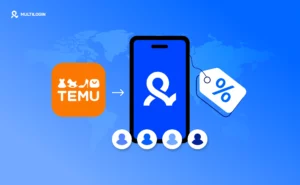Table of Contents
Bot Detection
Detecting and managing bots that interact with online services and websites is referred to as bot detection. As the internet grows, detecting bots has become more important for the purpose of maintaining integrity and security on-line.
Website owners, developers and anyone interested in online security will need to know about bot detection. This involves using various technologies and techniques to differentiate between actual human users from automated bots.
What is Bot Detection?
Artificial intelligence helps identify and separate human users from automated scripts or Bots in bot detection. Bots refer to automated programs that can do various things on the internet.
Some are good like search engine crawlers that index web pages, while others are malicious such as bots that scrap content, commit fraud or launch DDoS attacks.
Benefits of Bot Detection
Securing Confidential Data
Bots frequently target sensitive data such as customer information, pricing details, proprietary content etc., which they help secure through unauthorized entry identification.
Blocking Fraudulent Acts
Hackers mostly use bots to carry out fraudulent activities, such as fake account creation, payment fraud, and ad fraud. This is more reason you need a bot detection system in place. Having bot detection measures can help prevent these activities and protect your business from financial losses.
Enhancing Website Performance
Malicious bots generate a significant amount of traffic, leading to slower website performance and increased server costs.
Detecting such types of activities make website performance better hence reducing operational costs.
Better User Experience
Slowing down website performance or causing downtime is one way in which the user experience is disrupted by bots.
Avoiding any disruptions related to a bot should be your aim so you can maintain smoothness on your site all time.
Accurate Analytics
Fake traffic generated by robots distorts web analytics data. Ultimately leading to incorrect business decisions based on inaccurate data.
Real results come out making companies relying upon it have their own insights based on genuine human interactions only when there is no interference from these kinds of robots.
How Bot Detection Works
User habit and trends are studied to identify patterns that might indicate automated actions. These methods can be as simple as checking how fast requests come in or using machine learning algorithms.
Ways Bots Get Detected
Behavioral Analysis
The fundamental brick of bot detection is behavioral analysis, which monitors and examines user interaction on a website to establish patterns that may point towards the activity of bots.
For example, an average human visitor takes their time going through content and interacting with different elements on the page, whereas a computer program may just skim through numerous pages or perform repetitive tasks at very high speeds.
How Does Behavioral Analysis Detect Bots?
It looks at user behavior against normal human activities. Some anomalies include unusually quick navigation, repetitive clicking or zero mouse movements that might imply robotization.
For these bot detections using behavioral analysis would give insights into identifying these clues for example.
CAPTCHA and reCAPTCHA
CAPTCHA challenges were developed to enable humans differentiate themselves from web bots.
Those challenges are easy for any human but very difficult for any software bot. They go further to combine it with behavioral analysis in Google’s reCAPTCHA to make even more secure like this.
How Does reCAPTCHA Detect Bots?
Machine learning algorithms are employed by the latest versions of reCAPTCHA which analyze the user’s action during the challenge and also before it starts.
It takes into account elements like mouse motions, response time for the task, and general internet habits in order to establish whether an individual is a human being or a robot. This procedure is extensively discussed in CAPTCHA and reCAPTCHA technology.
IP Reputation
IP reputation tracking is another critical method for detecting bots. In this case, IP addresses are monitored over time.
Any IP address that has associations with malicious acts or any unusual traffic patterns can be flagged as suspicious and blocked from accessing the website.
How Do Websites Use IP Reputation to Detect Bots?
Websites keep records of IP addresses linked to malicious activities. During user access trials, these databases are checked against their internet protocol addresses (IP).
If it turns out that the IP location is suspicious then the site may block it or challenge the request hence thwarting possible bot activity on them.
In using IP reputation for effective bot management, we have explained this technique extensively.
Device Fingerprinting
Device fingerprinting is about creating a unique profile of a device based on its hardware and software characteristics such as browser type, operating system, and installed plugins.
The profile ensures that even if an individual changes their internet protocol address (IP), they will still be recognized by the same device through which they accessed the website before.
How Does Device Fingerprinting Detect Bots?
For instance, by comparing the device’s bio-data with known profiles it can identify anomalies indicating suspicious machines.
An example would be if a device purports to use an old browser version but has functionalities of modern day browsers thus being marked as a robot.
It is useful in detecting smart robots who frequently change their IPs in order to avoid detection further on this subject read more about browser fingerprinting and its applications in bot detection.
Machine Learning
Bot detection has been significantly transformed by machine learning process since it enables algorithms process massive data volumes thereby highlighting patterns indicative of automated routines.
Thus machine learning models get better with time in distinguishing between the behavior of human beings and those of robots.
How Does Machine Learning Enhance Bot Detection?
Machine learning models are fed on data sets that contain both human and bot samples. This way, they become adept at detecting subtle patterns as they refine their accuracy over a period of time using fresh information.
This method is particularly useful for identifying advanced bots that mimic human behavior closely.
How to Avoid Bot Detection
While it might seem like avoiding detection by bots does not matter for genuine users, this knowledge can enhance user experiences and guarantee easy access to websites.
These tips will help you avoid being detected as a bot:
- Mimic Human Behavior: Automated scripts should simulate natural browsing patterns, including realistic mouse movements and keystrokes.
- Use Residential IPs: Bots using residential IP addresses are less likely to be flagged than those using data center IPs.
- Rotate IPs and Devices: Frequently changing IP addresses and device fingerprints can help evade detection.
- Avoid Rapid Repetitive Actions: Implementing delays and varying actions can reduce the likelihood of being detected.
People Also Ask
Bot detection refers to techniques used to differentiate automated scripts or bots from humans.
Bot detection depends on various strategies such as behavioral analysis, CAPTCHA challenges, IP reputation tracking, device fingerprinting, and machine learning algorithms.
reCAPTCHA uses a combination of behavioral analysis and machine learning to assess user interactions and determine if the user is a human or a bot.
One can detect bot traffic by questioning the user behavior that looks objectionable, mapping IP addresses that seem suspicious and making use of iterations in machine learning to recognize irregularities.
It involves creating a unique profile of a device which is based on its hardware and software characteristics through which it can identify multiple visits and suspicious patterns.
Related Topics

How to use Pinterest for marketing: mobile-first strategy powered by Android emulation
Why marketers now rely on Android-emulation to unlock mobile-only

Stop buying aged TikTok accounts: build safer long-term profiles with Multilogin
TikTok has turned into one of the most important

Temu coupon codes for existing users: how to unlock more mobile discounts with Multilogin
If you have been shopping on Temu for a